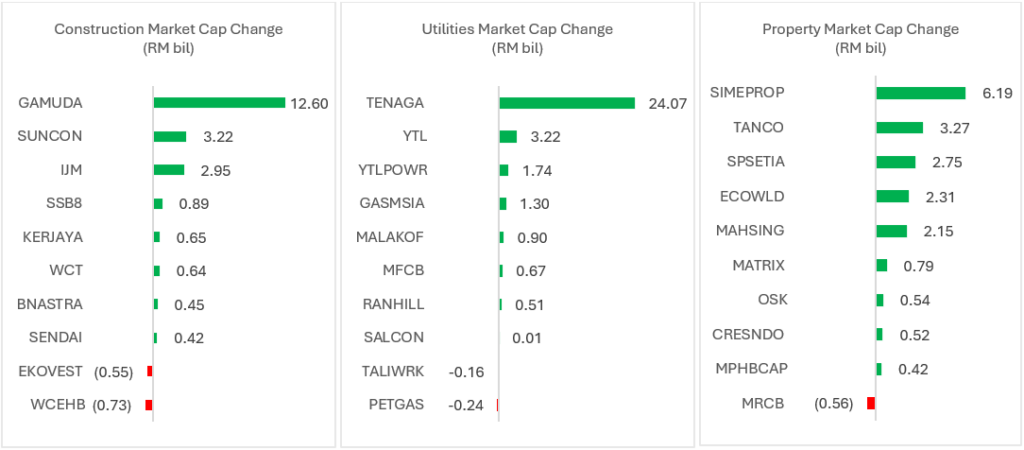I started taking investing seriously in 2016, and since then, reviewing the past year’s stock market performance has become an annual habit.
Why do I do this?
Mainly as a reflection tool to understand:
- What worked.
- What didn’t work.
- Missed opportunities to watch for.
- Potential risks to avoid.
This process helps me refine my instincts and improve my strategy for the years ahead. While there are other benefits, these four questions have been the most valuable for keeping me focused and prepared.
This year is no exception, but for the first time, I’m sharing my observations with you. So, without further ado, let’s jump straight in.
1. How has Bursa Malaysia performed in 2024?
The KLCI gave a tantalising and refreshing performance after being a disappointment for many years. In fact, last year’s performance of 12.9% eclipsed all the previous bull markets going back to 2011. Regionally, we even performed much better than most ASEAN countries, only second behind Singapore at 16.9%.


Digging deeper, 19 out of 30 KLCI constituents went up, adding RM130bil market cap into the index. It was not only specific group of stocks that were pulling the weight, it was most of them.
The top contributors have been TENAGA, CIMB and SUNWAY while top detractors were PCHEM, CDB and NESTLE.

The broad-based bull market was even more obvious when looking across most major local indices; from small cap to top 100. The most encouraging one is the performance of the next 70 largest market cap companies (MID70), going up almost 30%!

2. What drives this surprising performance in 2024?
To answer this, we must answer how different 2024 vs 2023 was.
For starters, the general outlook for 2024 was much brighter despite all the geopolitical tensions and major elections happening around the world. Talk about economic recession was slowly lingering away. Elevated inflation was moderating with commodity prices normalising downwards, allowing businesses to switch into risk-on mode.
On the local front, the ongoing US-China trade war continues to benefit Malaysia. Many businesses announced investments in more neutral countries like ours to diversify their supply chains. A more stable political environment also helped this with the coalition government begins its second year with stronger majority to chart economic policy and direction. The National Semiconductor Strategy, Green Investment Strategy and Special Economic Zones are some initiatives and policies announced to name a few.
As a result,
- As at 9M2024 foreign direct investment approved hits RM254.7 bil up 11% compared to same period last year.
- World Bank has revised upwards its projection for Malaysia’s economy to 4.9% in 2024 due to stronger-than-expected household spending, and improved investment and trade performance in the first half of 2024.
- IMF also revised its forecast last November for Malaysia’s real GDP growth for this year to 4.8% from 4.4% in April largely supported by strong domestic demand and exports.
These performances did not go unnoticed as more foreign funds flowed into the local stock market, reaching its peak in September, before a year-end pullback caused reversal of the flow due to global uncertainties – Trump elections and the Fed’s response to ongoing inflation challenges. All-in-all, it was a good year for the economy and Bursa Malaysia.

3. Which sectors were winning?
The biggest winners in 2024 were construction, utilities and property sectors. These 3 sectors continued their excellent performance in 2023 into 2024 owing to many major infrastructure projects and investments: from the East Coast Rail Link to the Pan-Borneo Highway development to the data centre hub development in Johor.

For each sector, the top performers in terms of market cap were Gamuda for construction, Tenaga for utilities and SIMEPROP for property.
| Sector | Top Performer | Change in Market Cap (RM bil) |
% in stock price | Catalyst |
| Construction | Gamuda | 12.6 | +88% | DC contract awards |
| Utilities | Tenaga | 24.1 | +39% | Critical NETR enabler for energy |
| Property | Sime Darby Property | 11.4 | +118% | Exposure to industrial segment |
Looking at the top 10 movers in construction, utilities and property sectors shows bright green colours, indicating a strong performance across companies, with each sector adding RM20.5b, RM32.0b and RM18.4b market cap respectively.

Who is buying and bidding up the prices of these stocks in these 3 sectors?
Well no surprise it’s always the foreign investors. However, one interesting trend to note is that they were not the only net buyer in the market, as local institutions playing its part in pushing the price to elevated level when foreign funds reversed, something that we don’t often see recent times, signifying their strong bullishness on this particular side of the economy.
On the other hand, local retailers were the only net sellers.

4. Which sectors were losing?
Telco & Media and Consumer continued its losing streaks from 2023 into 2024, as consumers cut spending to better cope with inflation, leading to subdued corporate earnings.
The lack of major catalysts and government uncertainty on 5G implementation also contributed to the weakened overall sentiments towards the sectors.

As expected, foreign funds were the net sellers for these 2 sectors, and yet again local institutions were there to support the market as net buyers – potentially picking on stocks with depressed valuations.

5. Conclusion for 2024
For such a long time, we finally have the year 2024, when the local stock market performed much beyond everyone’s expectations, except for a few underperforming sectors. This shows how supportive economic policies, efficient deal-making, and political stability can significantly impact investor returns.
As someone who invests based on business and economic fundamentals, it’s clear that Bursa Malaysia benefited from a strong economic setup. The key is identifying which sectors gain first (top-down approach) and then focusing on specific industries and companies (bottom-up approach).
In the past, I didn’t pay much attention to the broader economic picture. However, 2024 highlighted the importance of understanding macroeconomic trends and market catalysts to uncover hidden opportunities.
This is an important reminder of how I can continue to sharpen my strategy going forward.
2025 Outlook
I have to admit, I haven’t yet conducted a detailed analysis of the economy and sectors for 2025, so I can’t provide a concrete outlook at this time. However, one thing remains certain: the future is unpredictable. To navigate this, investors should stay informed, vigilant, patient, and ready to act when opportunities arise. These qualities are essential for strong, fundamentals-based investing.
I plan to share a more detailed sector-by-sector outlook in future editions here at 1.1 Investing. This will allow you to provide the necessary check and balance.
I hope you enjoy my sharing above, and feel free to comment below if you think I missed anything important. I’ll see you in the next update!
Please invest intelligently,



